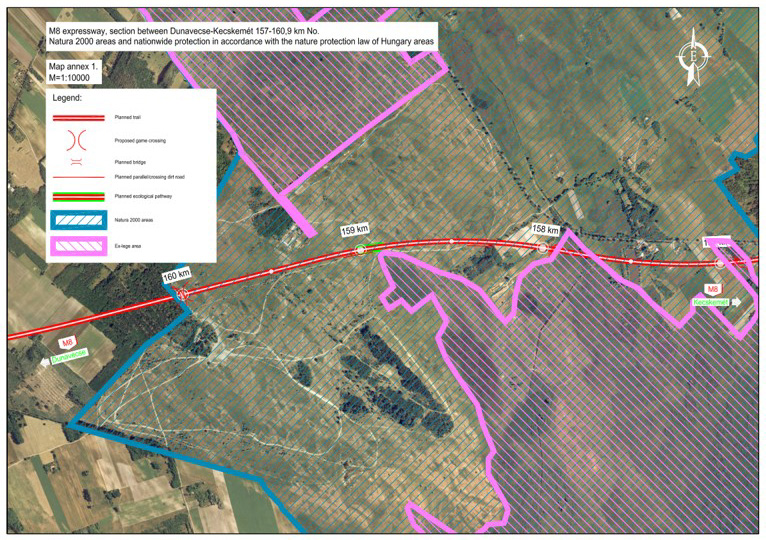Case Study
Natura 2000 appropriate assessment of a car factory
Contact name
András Schmidt
Institution name
Ministry of Agriculture
Region & country
Győr, Western Transdanubia region - Hungary
Summary
A car factory proposed to expand its activity in the municipality area of the city of Győr, Hungary, and construct a new factory building on a Natura 2000 site. It was claimed that there was no alternative to the chosen site. In the appropriate assessment procedure, the environmental authority requested via the Ministry the opinion of the European Commission, which gave a positive opinion, but compensation for the values lost had to be approx. 3,5-fold. Mitigation and compensation measures were paid for by the company and included the designation of new state-owned Natura 2000 sites, as well as measures to enhance the condition of existing Natura 2000 sites (measures that went beyond the regular duties to maintain or improve the site’s character).

M8 expressway between Natura 2000 areas and nationwide protection
Image by: András Schmidt
Background of the project
The Natura 2000 site affected by the development was HUFH20009 “Gönyűi-homokvidék” Site of Community Importance. Previously, the site was in a relatively good, semi-natural condition and the chosen sites improved by the compensation measures needed better management (due to invasive species as well as the remains of former military activities etc.). Hungary had not requested the opinion of the European Commission before in an appropriate assessment procedure.
Hungary claimed, based on calculations of the car factory, that the development would create several thousand (up to ten thousand) new jobs, while the natural values lost would be properly compensated. It was claimed that the factory needed to be built on the given Natura 2000 site, other alternatives would not be viable economically.
Solution and actions taken
The European Commission granted a positive opinion, and therefore a 3,5-fold compensation level had been negotiated to make up for natural values lost due to the development. The compensation also had to be negotiated with the management of the car factory, as they had to cover the costs. As such, two site extensions and one new site have been designed as part of the compensation measures.
343 ha of the habitat type 6260 (Pannonic sand steppes) were added to the Natura 2000 network in Hungary. For this purpose sites HUKN20014 “Hajósi Homokpuszta” and HUFH20009 “Gönyűi-homokvidék” were expanded by 335 ha (including 219 ha of this habitat type) and a new site “Kékhegyi Lőtér” were designated covering the area of 460 ha (including 124 ha of this habitat type). 230 ha of these grasslands will be subsequently subject to restoration measures. Additionally, 258 ha of this habitat type were either established or restored within existing Natura 2000 sites (“Gönyűi-homokvidék” and HUDI20046 “Szigeti Homokok”). Compensatory measures aimed at Pannonic sand steppes also off set negative impacts on Iris humilis ssp. arenaria and Carabus hungaricus by establishing or restoring a habitat typical for these species.
As regards the habitat type 91I0 (Euro-Siberian steppic woods with Quercus spp.), site HUDI20040 “Gödöllői-dombság Peremhegyei” was enlarged by 41 ha, adding 14 ha of this habitat type to the network. 31 ha of this habitat type was also be subject to restoration measures on the “Gönyűi-homokvidék” site. Compensatory measures aimed at steppic woods were also offset negative impacts on Cerambyx cerdo and Lucanus cervus by means of extending protection to the old oak woodlands on the “Gödöllői-dombság Peremhegyei” site where these species occur and by making this habitat more suitable for these species (transformation of the downgraded or artificial wood stands into more natural ones).
Additionally, 13 ha of the habitat type 91N0 (Pannonic inland sand dune thicket)were established on the “Gönyűi-homokvidék” site to compensate the losses in this type of woodland.
Other institutions or parties involved
- Numerous other organisations were involved in the process, in co-ordination by the office responsible for foreign investments (a background institute of the Ministry of Economy);
- State forest companies and national park directorates in whose territories the compensation measures were carried out.
Results
The car factory has been constructed and is in operation. The compensation measures have been duly carried out in the last 6 years, creating, and restoring trigger habitats. Monitoring carried out by a team of experts commissioned by the car factory assessed that the species associated with restored habitats have increased their populations on the given sites.
Challenges
Finding the appropriate sites for compensation of certain Natura 2000 trigger habitats and species, as most of the sites for these habitats and species had already been designated as Natura 2000 sites. The compensation sites also had to be state-owned (otherwise private owners would have to be compensated for Natura 2000 designation).
Lessons learned
Application of Article 6(4) of the Habitats Directive (HD), for achieve the positive opinion of the European Commission is very demanding, with several dozen preparatory meetings to design every step with each stakeholder (e.g. site managers and authorities) concerned.
Transposition of Article 6(4) of the Habitats Directive must be precise and detailed transposition and national guidance documents (also translation of EC guidance) are essential.
Good communication with other sectors, and also between levels (ministries, authorities and national park directorates).
HD made our life more complicated but is crucial because also contributed for saving nature (and ourselves).
Contact name
András Schmidt
Institution name
Ministry of Agriculture
Website(s)
